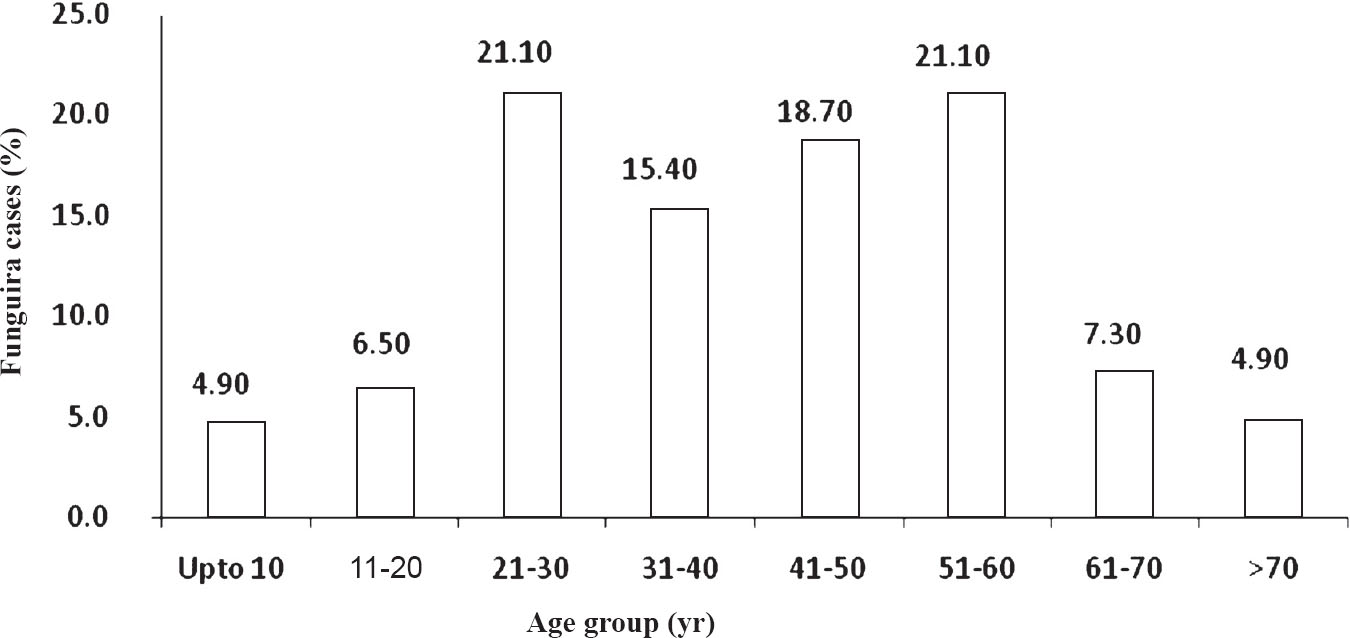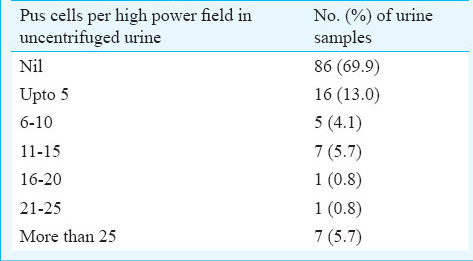Translate this page into:
Fungal profile of funguria cases at a tertiary care hospital in southern India
Reprint requests: Dr Rakesh Singh, Associate Professor, Department of Microbiology, Jawaharlal Institute of Postgraduate Medical Education & Research, Puducherry 605 006, India e-mail: drrakesh1976@yahoo.com
-
Received: ,
This is an open-access article distributed under the terms of the Creative Commons Attribution-Noncommercial-Share Alike 3.0 Unported, which permits unrestricted use, distribution, and reproduction in any medium, provided the original work is properly cited.
This article was originally published by Medknow Publications & Media Pvt Ltd and was migrated to Scientific Scholar after the change of Publisher.
Abstract
Background & objectives:
Candida albicans is the most common aetiological agent in funguria cases commonly observed in hospitalized patients. But a few reports are available from India where non-albicans Candida species have accounted for >50 per cent of urinary Candida isolates. We undertook this study to know the fungal profile amongst funguria cases.
Methods:
A total of 123 consecutive fungal isolates obtained from clinically suspected cases of urinary tract infection from April to September, 2013, were included. Yeast species was identified by standard phenotypic methods. Antifungal susceptibility testing of yeast was performed for fluconazole (25 μg) by disc diffusion method as per Clinical and Laboratory Standards Institute (CLSI) guidelines.
Results:
The male to female ratio was 0.92. The mean age of patients was 42.7 ± 18.9 yr. C. tropicalis (58.5%) was the most common fungal agent followed by C. albicans (30.1%). Only one isolate of C. tropicalis was resistant to fluconazole.
Interpretation & conclusions:
C. tropicalis and C. albicans were the predominant fungal pathogens responsible for urinary tract infection. Less resistance to fluconazole observed in the study may be due to restricted use of fluconazole in this area.
Keywords
Candida
candiduria
funguria
urinary tract infection
The presence of fungus in urine or funguria is a common finding at a tertiary care hospital. Candiduria is observed in 16-22 per cent of hospitalized patients12. The common risk factors for funguria are female sex, extremes of age, intensive care unit (ICU) admission, urinary catheterization, diabetes mellitus, and broad-spectrum antibiotic therapy1234. Though Candida albicans is the most common aetiological agent1245, but reports are available where non-albicans Candida species accounted for > 50 per cent of urinary Candida isolates36. These include C. tropicalis, C. glabrata, C. parapsilosis and C. krusei1346. It is important to identify the species of Candida in such cases as different species have different antifungal susceptibility, for example C. krusei is known to be inherently resistant to fluconazole7. There is a paucity of literature on fungal profile in funguria cases especially from our country. Hence, this study was undertaken to know the fungal profile amongst funguria cases and to know the antifungal susceptibility status at a tertiary care hospital in southern India.
Material & Methods
All consecutive 123 fungal isolates obtained from urine specimens received from clinically suspected cases of urinary tract infection at the Department of Microbiology, Jawaharlal Institute of Postgraduate Medical Education and Research (JIPMER), Puducherry from April to September, 2013, were included in the study. Associated underlying conditions were recorded. Presence of pus cells and yeast cells in microscopic examination of uncentrifuged urine samples was also recorded. Yeast species was identified by combination of germ tube, CHROM agar (Hi-Media, Mumbai) and morphology on corn meal agar methods containing 1 per cent tween 8018910. Antifungal susceptibility testing of yeast was performed for fluconazole (25 μg) by disc diffusion method as per Clinical and Laboratory Standards Institute (CLSI) guidelines11. Categorical variables were expressed as frequencies and percentages and continuous variables were expressed as mean with standard deviation. The study protocol was approved by the Institute Ethics Committee.
Results & Discussion
Of the 123 fungal isolates, 64 (52%) were obtained from female patients. The male to female ratio was 0.92. The mean age was 42.7 ± 18.9 yr. An age-wise distribution of funguria cases is shown in the Figure. Maximum cases of funguria were seen in 21-30 and 51-60 yr age group.

- Age-wise distribution of funguria cases.
Common underlying conditions were ICU admission (17.9%), surgical procedures (9.8%) and diabetes mellitus (6.5%). Yeast cells were observed in 49 (39.8%) funguria cases. Pus cells per high power field observed in uncentrifuged urine is shown in the Table. Concomitant bacteria were also isolated in 23 (18.7%) funguria cases. Enterococcus faecalis was isolated in 11 (8.9%) cases, Escherichia coli in 10 (8.1%) cases and Pseudomonas spp. in 2 (1.6%) cases. Candida tropicalis was the most common fungal isolate (58.5%) followed by C. albicans (30.1%). C. glabrata, C parapsilosis and Trichosporon spp. were found in 3.3 per cent cases each. Single isolate each of C. krusei and C. kefyr were isolated in this study.

Germ tube test was positive in 38 (29.3%) Candida isolates. All germ tube test positive isolates were C. albicans. Only one C. albicans isolate was germ tube negative. Only one isolate of C. tropicalis was observed resistant to fluconazole.
Fungal urinary tract infection or funguria has become an important nosocomial infection over the past decades. About 15 per cent of urinary tract infections are caused by Candida spp11213. Though funguria is frequently observed in females but a few studies have observed more cases of funguria among males (61.4%) as compared to the females (38.6%) in catheterized ICU patients3. The male to female ratio was 0.92 in our study indicating that female cases were marginally more than the male cases. Most of the funguria cases were adults (76.4% were 21-60 yr of age). There were two peaks of funguria cases: one at 21-30 yr and another was 51-60 yr. Elderly people are at higher risk of funguria because of decreased immunity in advance age34.
One of the limitations of the study was that there was no uniformity in recording the associated conditions in requisition proforma. Another limitation was that participants were not followed up for the response to the treatment and outcome.
Pyuria (>5 pus cells/high-power field) was observed only in 17.1 per cent of funguria cases. Hence, funguria was not associated with the presence of pus cells in urine in our study. Presence of pus cell in funguria cases may be due to coexistent bacterial infection or mechanical injury of the bladder mucosa by indwelling urinary catheter. Bacterial co-infection was observed in 18.7 per cent of funguria cases in the current study. C. tropicalis was the most common fungal isolate found in urinary tract infection, followed by C. albicans. Similar fungal profile has been reported by other studies from India31415, whereas C. albicans was the most common isolate followed by C. glabrata from studies done outside India1416171819. Single isolate (2.7%) of C. albicans in the present study was germ tube negative. Four (3.3%) isolates of Trichosporon spp. were isolated in urine specimen which is scarcely reported in literature in funguria cases19. Isolation of Trichosporon spp. was also reported in a study from Chandigarh, India6. Only single isolate of C. tropicalis was resistant to fluconazole while 18.6 per cent isolates of C. tropicalis were observed to be resistant to fluconazole in another study from India6. Less fluconazole resistance observed in our study may be because of restricted use of fluconazole in southern part of India as compared to the northern part.
Acknowledgment
Authors acknowledge the Indian Council of Medical Research (ICMR), New Delhi, for granting STS ICMR project to the first author (SPS).
References
- Candiduria in hospitalized patients in teaching hospitals of Ahvaz. Iran J Microbiol. 2012;4:198-203.
- [Google Scholar]
- Candiduria in hospital patients: a study prospective. Mycopathologia. 2004;158:49-52.
- [Google Scholar]
- Candiduria in catheterized intensive care unit patients: emerging microbiological trends. Indian J Pathol Microbiol. 2011;54:552-5.
- [Google Scholar]
- Prospective multicenter surveillance study of funguria in hospitalized patients. The National Institute for Allergy and Infectious Diseases (NIAID) Mycoses Study Group. Clin Infect Dis. 2000;30:14-8.
- [Google Scholar]
- Candidemia and candiduria in critically ill patients admitted to intensive care units in France:incidence, molecular diversity, management and outcome. Intensive Care Med. 2008;34:292-9.
- [Google Scholar]
- Candida colonization in urine samples of ICU patients: determination of etiology, antifungal susceptibility testing and evaluation of associated risk factors. Mycopathologia. 2012;174:149-55.
- [Google Scholar]
- Azole resistance in neonatal intensive care units in Argentina. J Chemother. 2005;17:347-50.
- [Google Scholar]
- Fungi. In: Collee JG, Fraser AG, Marmion BP, Simmons A, eds. Mackie and McCartney practical medical microbiology. London: Churchill Livingstone; 1999. p. :695-717.
- [Google Scholar]
- Hichrom candida agar for identification of Candida species. Indian J Pathol Microbiol. 2010;53:93-5.
- [Google Scholar]
- Simple, reliable, and cost-effective yeast identification scheme for the clinical laboratory. J Clin Microbiol. 1999;37:422-6.
- [Google Scholar]
- Clinical and Laboratory Standards Institute (CLSI). Methods for antifungal disc diffusion susceptibility testing of yeasts; Approved guideline. In: CLSI document M44-A2 (2nd ed). Wayne, PA: CLSI; 2009.
- [Google Scholar]
- Evaluation of nosocomial infections and risk factors in critically ill patients. Med Sci Monit. 2011;17:17-22.
- [Google Scholar]
- Etiology and antibiotic susceptibility patterns of community- and hospital-acquired urinary tract infections in a general hospital in Kuwait. Med Princ Pract. 2010;19:440-6.
- [Google Scholar]
- Candiduria in a public hospital of São Paulo (1999-2004): characteristics of the yeast isolates. Rev Inst Med Trop Sao Paulo. 2007;49:349-53.
- [Google Scholar]
- Candiduria in those over 85 years old: a retrospective study of 73 patients. Intern Med. 2011;50:1935-40.
- [Google Scholar]
- Distribution and antifungal susceptibility of Candida species causing nosocomial candiduria. Med Mycol. 2012;50:529-32.
- [Google Scholar]
- Microbiological characteristics of yeasts isolated from urinary tracts of intensive care unit patients undergoing urinary catheterization. J Clin Microbiol. 1999;37:1584-6.
- [Google Scholar]






